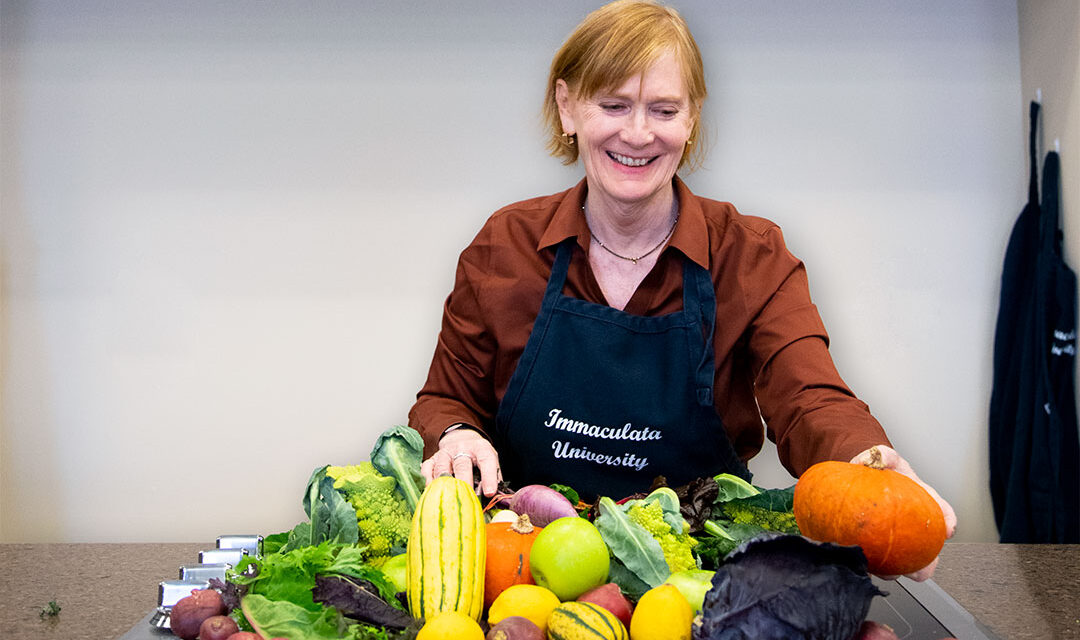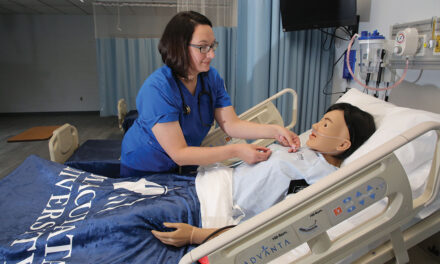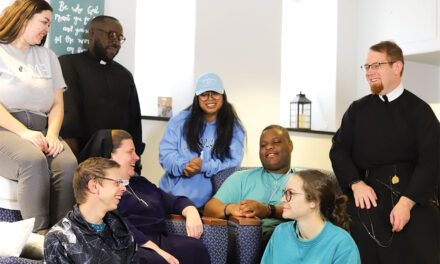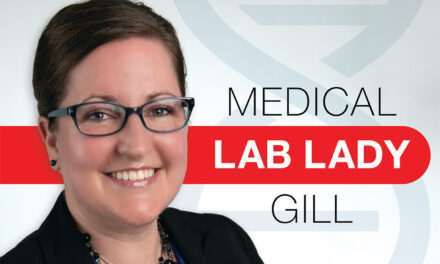From the culinary world to clinical settings, and from caring for her father during his cancer treatment to helping oncology patients get adequate nutrients, Audrey Caspar-Clark ’00, ’09 M.A., has a range of personal and professional experiences with food. She has been a registered dietitian at Penn Radiation Oncology and the Abramson Cancer Center for 18 years, helping patients nourish themselves during and after treatment.
Early in her career, Caspar-Clark worked in restaurants, went to culinary school and spent some time backpacking in Europe, savoring Spanish paella and granitas. When she left restaurant work to raise three children, she used her cooking skills to make vegetarian meals for them, including crispy tofu and from-scratch pizza and pasta.
When Caspar-Clark’s father was diagnosed with head and neck cancer, he had to give up most of the foods he had loved and rely on a feeding tube instead. “As he lost his ability to enjoy the taste of food, my toddlers were having their first experiences with a wide array of new foods, tastes and textures—all of which fostered a growing interest in human nutrition,” she told the American Institute for Cancer Research in an interview for their website.
Immaculata was just five minutes from Caspar-Clark’s home and offered nutrition programs, which were not commonly available at other local institutions at the time. She chose to earn both her bachelor’s and master’s degrees in nutrition there and appreciated the flexibility and support she received as an adult student. “I had a lot of interruptions in my undergraduate program, and part of why I loved Immaculata so much was because everyone was so supportive of me being a mother of small children.” Sometimes she brought her children to class in a stroller, and she fondly remembers how the IHM Sisters made a fuss over her kids. “I have a tremendous soft spot in my heart for Immaculata.”
Caspar-Clark enjoyed taking an ethics course and learning to think critically about the ethical aspects of food insecurity, homelessness and mental illness. Her class considered questions related to social supports and discrimination. “How do we care for everyone without thinking, ‘This person doesn’t deserve it’?” she pondered.
One of Caspar-Clark’s nutrition instructors was a practicing dietitian who shared case studies of her patients with students and asked what they would do in those scenarios. “It really helped me to take my book learning and turn it into real life,” Caspar-Clark said.
Science is the foundation of nutrition, she added. “I learned how important it is to read journals and scientific articles and how to interpret studies,” using evidence as the basis for nutrition recommendations. For her master’s research project, she designed a quality improvement project with the food service department at the Hospital of the University of Pennsylvania, where she was doing her dietetic internship. She educated the staff about how to handle food safely for immunosuppressed patients and what foods were and weren’t appropriate for their specific diet.
“Healthy eating is a lifelong thing.”
Caspar-Clark also studied medical nutrition therapy at both the undergraduate and graduate level at Immaculata, learning how to calculate the amount of nutrients to meet patients’ unique needs. As an oncology dietitian, she provides specialized support for patients who may not be able to chew or who have had part of their gastrointestinal tract removed. At Penn, she collaborates with other medical practitioners to treat patients with complex cases or rare forms of cancer that may require clinical trials or other treatment options.
“Probably a third of the dietitians I’ve worked with at Penn have been Immaculata graduates,” Caspar-Clark said. “It’s been a very strong program for decades. It’s highly respected.”
Her clinical training coupled with her culinary background helps Caspar-Clark provide additional food options for patients whose appetites decline during their cancer treatment. They may lose substantial weight and struggle to eat enough, unable to enjoy the simple pleasure of a meal.
“Quality of life issues are really important,” Caspar-Clark said. She is mindful of “how drastically people’s lives change with a cancer diagnosis. It affects digestion, metabolism, taste buds, all these things that we take for granted that no longer function the way we’re used to.” She remembers one patient with head and neck cancer who could no longer swallow most foods and used liquid nutrition instead. But he told her that every week, he bought a freshly baked bagel and savored the smell of it.
Although Caspar-Clark’s caseload includes patients with a range of cancer types, she has special compassion for patients like this man who had head and neck cancer like her father. “It’s something my dad would be proud of me for doing, because he would know that I try very hard to help patients find ways to stay nourished [and feel] like they have some control,”
she reflected.
“It’s really important to help patients have something that gives them pleasure,” Caspar-Clark said. She encourages patients to eat a balanced diet that includes “care and comfort nutrition,” such as a favorite dessert from childhood. Sometimes family members are afraid to let their loved one eat a cookie or ice cream, mistakenly believing that sugar feeds cancer. “An 800-calorie milkshake is sometimes the right thing,” Caspar-Clark said. For cancer patients struggling to eat enough, she said, “don’t make them a smoothie with kale in it—it’s not the same!”
For patients who can tolerate more foods, Caspar-Clark recommends smoothies as a simple way to incorporate fruits and vegetables in their diets. Some of her patients don’t know how to cook or are too tired to prepare foods, so she suggests frozen vegetables, nuts and seeds as easy sources of nutrients.
She also points them to resources and recipes from the American Institute for Cancer Research (AICR). “Patients and their loved ones are frequently bombarded with information coming from a wide array of sources. Some of these sources are unreliable and occasionally predatory, with intent to sell dietary supplements or other therapies that may be risky,” Caspar-Clark commented. “It is so important to have credible, evidence-based information that is visually attractive and easy to navigate like the resources from AICR.”
For patients whose head and neck cancer goes into remission, Caspar-Clark offers support groups beginning about a year after their last visit with her. “They look so terrific,” she said. They thank her for all the nutrition guidance she has given them. “Patients and their families are so appreciative.” She finds it rewarding to develop long-term relationships with patients, addressing their changing needs at each stage of treatment and recovery. “Healthy eating is a lifelong thing,” she said.

Favorite Recipes
Two family favorite recipes from Audrey Caspar-Clark ’00, ’09 M.A., registered dietitian at Penn Radiation Oncology and the Abramson Cancer Center
Potato Asparagus Salad
My family loves this dish. I always made it for our large family gathering at Easter. The amounts are based on serving at least 20 people, so feel free to scale down—this recipe is very forgiving.
- 10 lbs. potatoes (I like to use red skin)
- 3 lbs. fresh asparagus—remove tough woody stems and cut into inch-long pieces
- 3-6 shallots, minced, approx. 1 cup
- 1 bunch flat leaf parsley, chopped
- 1 bunch fresh dill, chopped
- Apple cider vinegar, about 1 cup
- Good quality extra virgin olive oil, 2 to 2 ½ cups
- Dijon mustard, about 3 tablespoons
- Salt and freshly ground black pepper
Make the vinaigrette: Add Dijon mustard and some salt and pepper to a large bowl. Add ½ the apple cider vinegar and whisk together to incorporate the mustard. Continue whisking and add the rest of the vinegar. Slowly add the olive oil to form an emulsion and taste. If too sharp or acidic, add more olive oil. If too oily, add in a bit more vinegar. Taste again to make sure there is enough salt.
Wash and sort the potatoes. If they are small, cut them in half and if larger, cut them into similarly sized pieces. Do not cut them too small as you want them to retain some integrity of shape. Steam or boil until fork tender and drain. Immediately add the vinaigrette dressing while the potatoes are warm and mix in the minced shallots. The potatoes can be prepared the day before and allowed to soak up the dressing. Make sure that all the potatoes are well coated in the dressing.
Steam the asparagus until they are bright green and still crisp. This may only take a few minutes. Immediately plunge into an ice bath (a large bowl with cold water and ice cubes). Drain well and chill in refrigerator until ready to serve. This will help the asparagus spears retain their bright green color and crispness.
When ready to serve, mix the chopped parsley, dill and asparagus in with the potatoes. Mix well and taste for seasoning—sometimes it needs a bit more salt and pepper. The salad should be nice and green and springy!
Oatmeal Pancakes
Adapted from “The Breakfast Book” by Marion Cunningham, Bridge Creek Oatmeal Pancakes. This recipe makes 12 four-inch pancakes. We often had these for dinner as I would mix up the oats and yogurt in the morning—the rest of the recipe comes together quickly.
- 2 cups plain yogurt (choose one that is more on the liquid-y side)
- 2/3 cup rolled oats (not steel cut or instant)
- 1 large egg
- 2 tablespoons brown sugar or maple syrup
- 1/3 cup all-purpose flour
- 1/3 cup whole wheat flour
- 1 tsp baking soda
- ½ tsp salt
- 2 tablespoons canola oil
At least six hours (overnight is fine) before making pancakes, mix the yogurt and the oats together in a bowl. If not moist enough, add a little milk. Cover and refrigerate.
Beat the egg well in a large bowl. Mix in the brown sugar or maple syrup. Add the flours, baking soda, salt, oil and oatmeal mixture. Stir until well blended.
Heat a griddle or skillet until hot and add small amount of canola oil to lightly coat the pan. Drop batter by tablespoons (about 2 ½ per pancake) on griddle and cook until lightly browned on both sides. Serve with some butter and maple syrup or warm applesauce with cinnamon.





